Analysis and Evaluation of Nursing Theory for Complex Adult Patient Care
VerifiedAdded on 2023/06/18
|14
|4866
|391
AI Summary
This assessment critically evaluates contemporary nursing theory for the care of complex adult patients, including discharge pathways and their impact on patient outcomes. The case background focuses on type-2 diabetes and the delivery of care, while also examining the development of current healthcare policy, standards, and professional guidelines. The assessment also discusses the role of the registered nurse and the importance of evidence-based practice in providing high-quality care. The influences impacting the organization and delivery of healthcare are also explored.
Contribute Materials
Your contribution can guide someone’s learning journey. Share your
documents today.
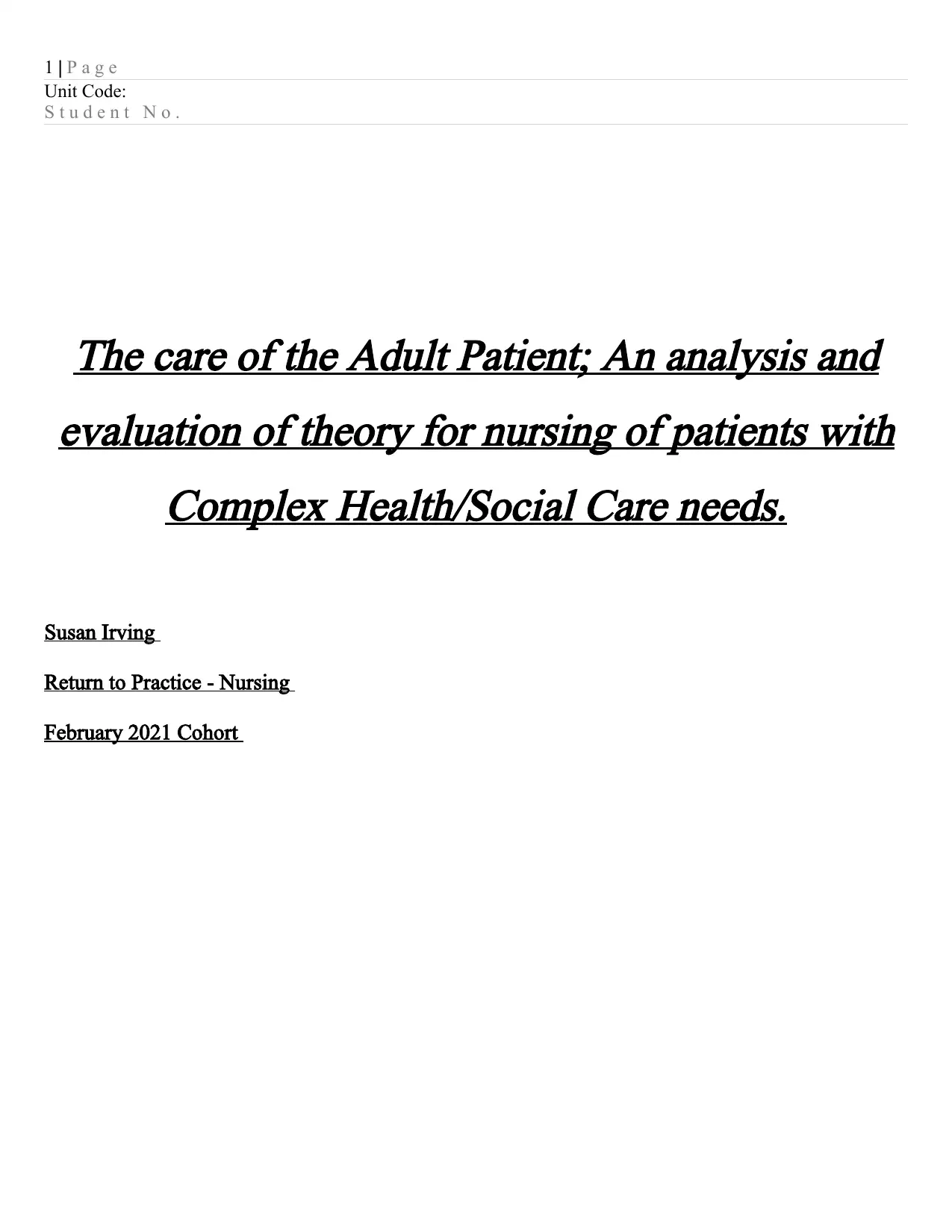
1 | P a g e
Unit Code:
S t u d e n t N o .
The care of the Adult Patient; An analysis and
evaluation of theory for nursing of patients with
Complex Health/Social Care needs.
Susan Irving
Return to Practice - Nursing
February 2021 Cohort
Unit Code:
S t u d e n t N o .
The care of the Adult Patient; An analysis and
evaluation of theory for nursing of patients with
Complex Health/Social Care needs.
Susan Irving
Return to Practice - Nursing
February 2021 Cohort
Secure Best Marks with AI Grader
Need help grading? Try our AI Grader for instant feedback on your assignments.
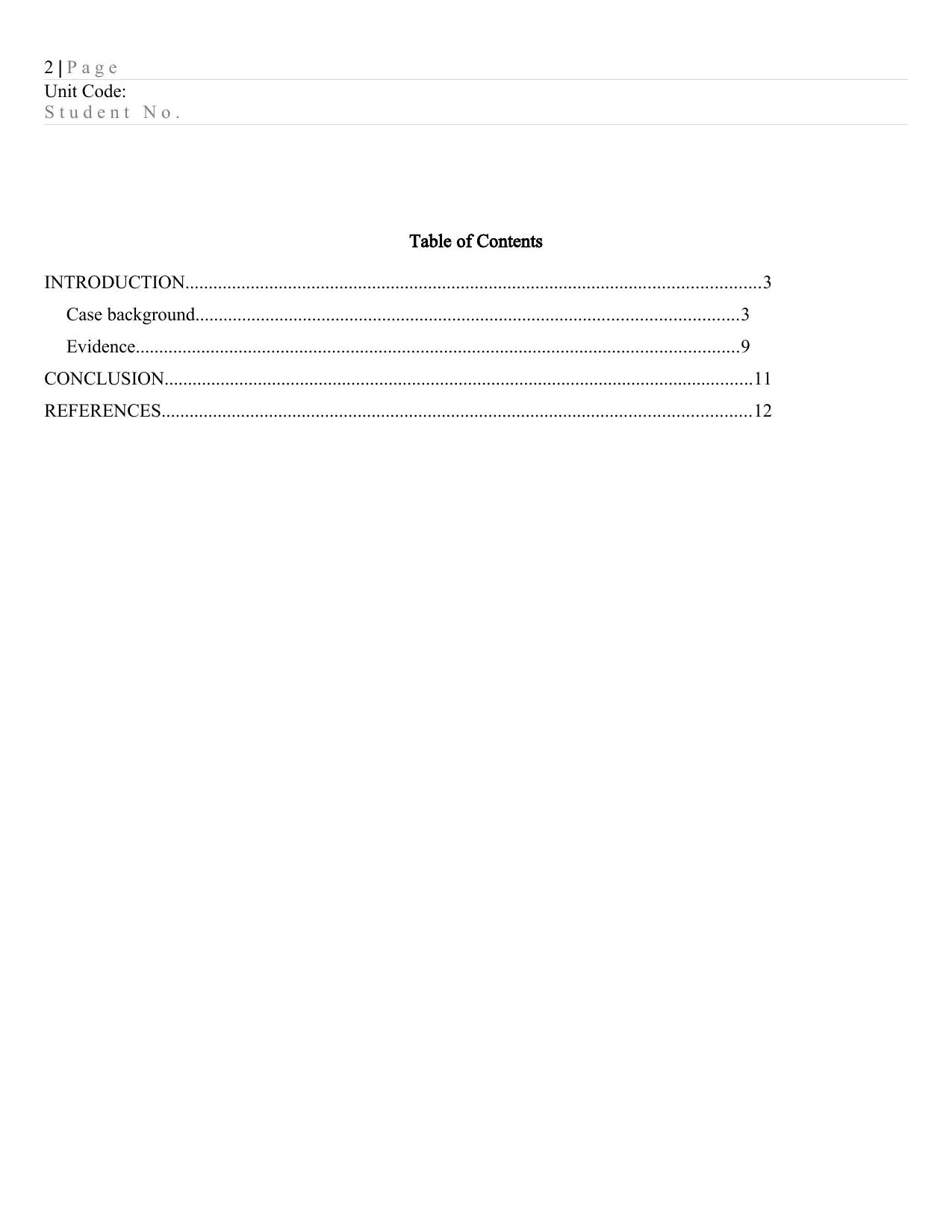
2 | P a g e
Unit Code:
S t u d e n t N o .
Table of Contents
INTRODUCTION...........................................................................................................................3
Case background....................................................................................................................3
Evidence.................................................................................................................................9
CONCLUSION..............................................................................................................................11
REFERENCES..............................................................................................................................12
Unit Code:
S t u d e n t N o .
Table of Contents
INTRODUCTION...........................................................................................................................3
Case background....................................................................................................................3
Evidence.................................................................................................................................9
CONCLUSION..............................................................................................................................11
REFERENCES..............................................................................................................................12
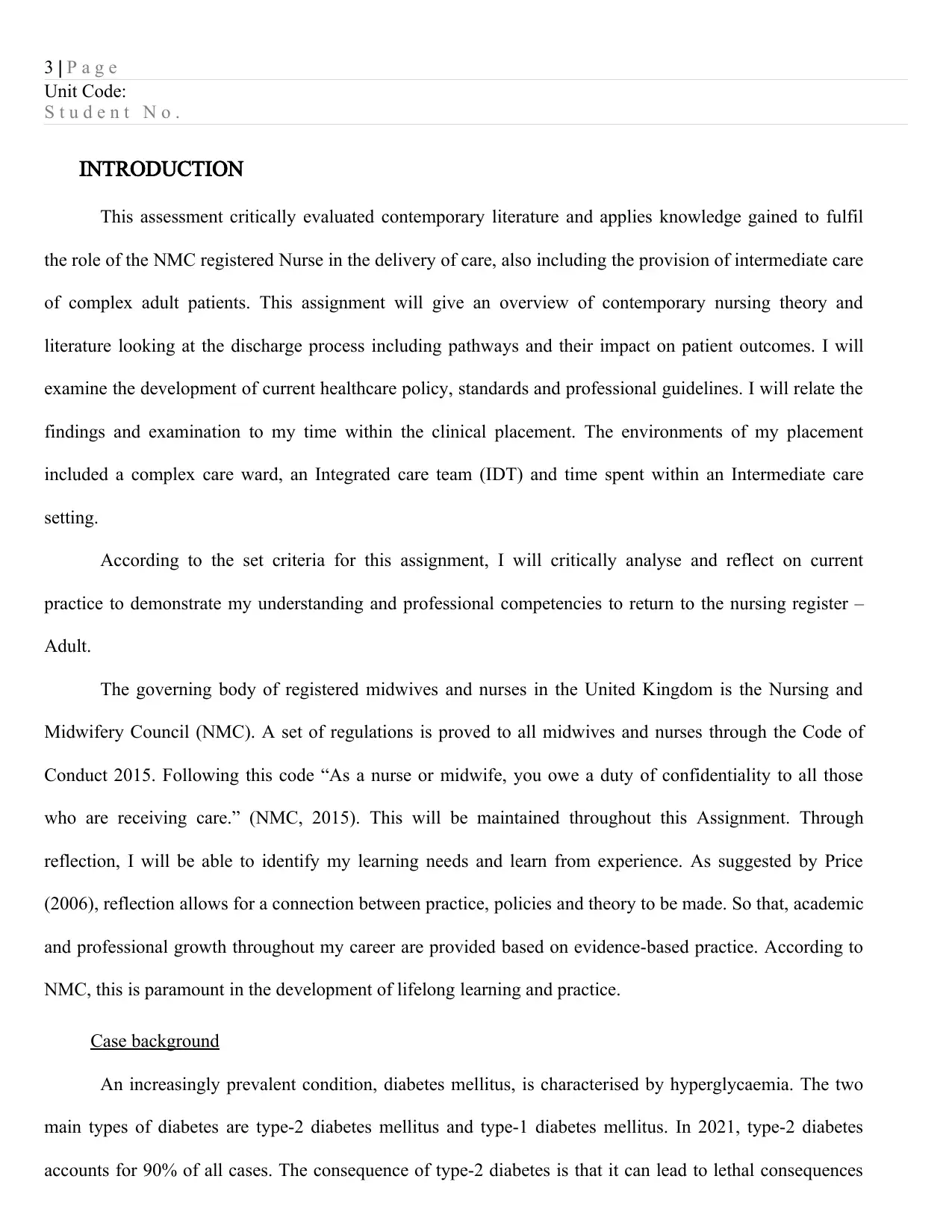
3 | P a g e
Unit Code:
S t u d e n t N o .
INTRODUCTION
This assessment critically evaluated contemporary literature and applies knowledge gained to fulfil
the role of the NMC registered Nurse in the delivery of care, also including the provision of intermediate care
of complex adult patients. This assignment will give an overview of contemporary nursing theory and
literature looking at the discharge process including pathways and their impact on patient outcomes. I will
examine the development of current healthcare policy, standards and professional guidelines. I will relate the
findings and examination to my time within the clinical placement. The environments of my placement
included a complex care ward, an Integrated care team (IDT) and time spent within an Intermediate care
setting.
According to the set criteria for this assignment, I will critically analyse and reflect on current
practice to demonstrate my understanding and professional competencies to return to the nursing register –
Adult.
The governing body of registered midwives and nurses in the United Kingdom is the Nursing and
Midwifery Council (NMC). A set of regulations is proved to all midwives and nurses through the Code of
Conduct 2015. Following this code “As a nurse or midwife, you owe a duty of confidentiality to all those
who are receiving care.” (NMC, 2015). This will be maintained throughout this Assignment. Through
reflection, I will be able to identify my learning needs and learn from experience. As suggested by Price
(2006), reflection allows for a connection between practice, policies and theory to be made. So that, academic
and professional growth throughout my career are provided based on evidence-based practice. According to
NMC, this is paramount in the development of lifelong learning and practice.
Case background
An increasingly prevalent condition, diabetes mellitus, is characterised by hyperglycaemia. The two
main types of diabetes are type-2 diabetes mellitus and type-1 diabetes mellitus. In 2021, type-2 diabetes
accounts for 90% of all cases. The consequence of type-2 diabetes is that it can lead to lethal consequences
Unit Code:
S t u d e n t N o .
INTRODUCTION
This assessment critically evaluated contemporary literature and applies knowledge gained to fulfil
the role of the NMC registered Nurse in the delivery of care, also including the provision of intermediate care
of complex adult patients. This assignment will give an overview of contemporary nursing theory and
literature looking at the discharge process including pathways and their impact on patient outcomes. I will
examine the development of current healthcare policy, standards and professional guidelines. I will relate the
findings and examination to my time within the clinical placement. The environments of my placement
included a complex care ward, an Integrated care team (IDT) and time spent within an Intermediate care
setting.
According to the set criteria for this assignment, I will critically analyse and reflect on current
practice to demonstrate my understanding and professional competencies to return to the nursing register –
Adult.
The governing body of registered midwives and nurses in the United Kingdom is the Nursing and
Midwifery Council (NMC). A set of regulations is proved to all midwives and nurses through the Code of
Conduct 2015. Following this code “As a nurse or midwife, you owe a duty of confidentiality to all those
who are receiving care.” (NMC, 2015). This will be maintained throughout this Assignment. Through
reflection, I will be able to identify my learning needs and learn from experience. As suggested by Price
(2006), reflection allows for a connection between practice, policies and theory to be made. So that, academic
and professional growth throughout my career are provided based on evidence-based practice. According to
NMC, this is paramount in the development of lifelong learning and practice.
Case background
An increasingly prevalent condition, diabetes mellitus, is characterised by hyperglycaemia. The two
main types of diabetes are type-2 diabetes mellitus and type-1 diabetes mellitus. In 2021, type-2 diabetes
accounts for 90% of all cases. The consequence of type-2 diabetes is that it can lead to lethal consequences
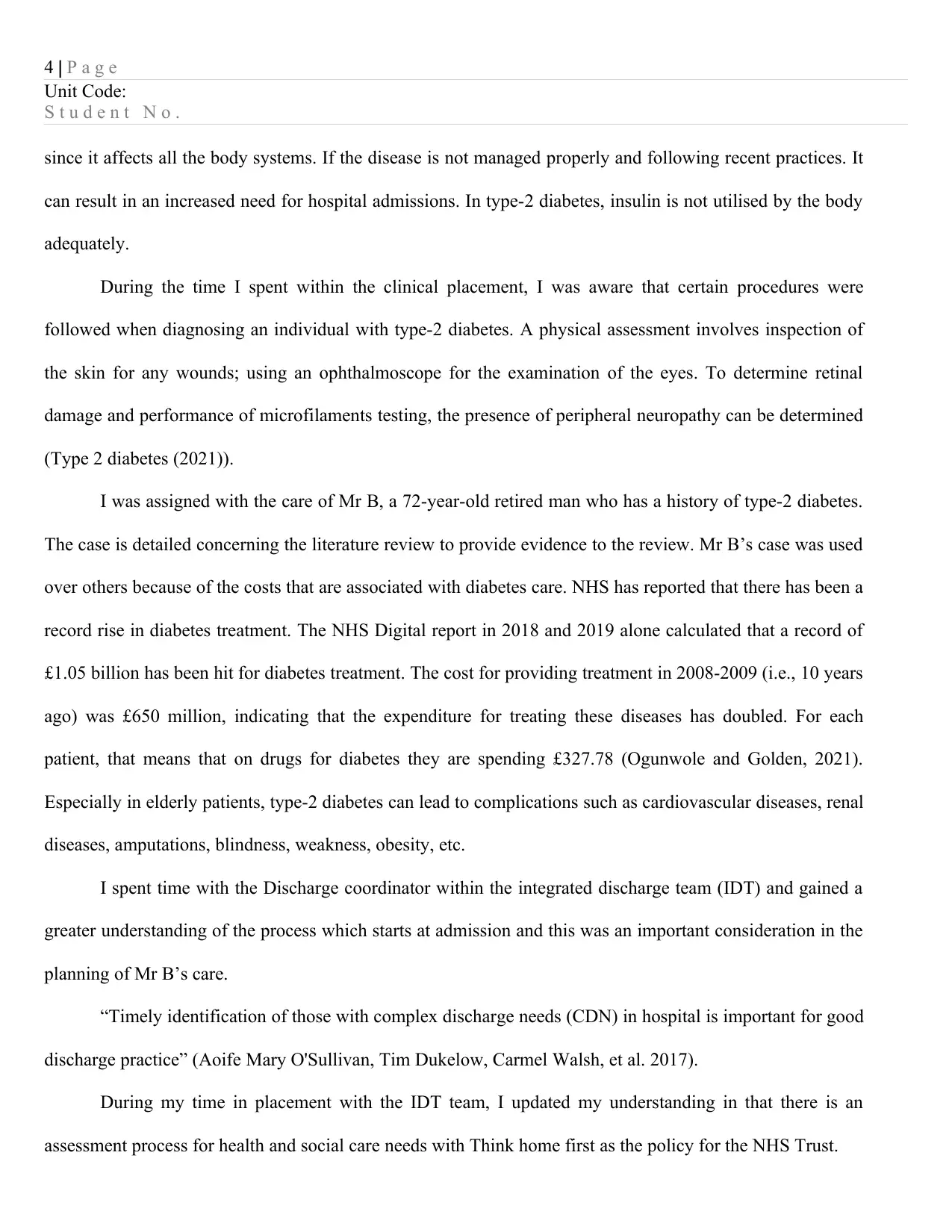
4 | P a g e
Unit Code:
S t u d e n t N o .
since it affects all the body systems. If the disease is not managed properly and following recent practices. It
can result in an increased need for hospital admissions. In type-2 diabetes, insulin is not utilised by the body
adequately.
During the time I spent within the clinical placement, I was aware that certain procedures were
followed when diagnosing an individual with type-2 diabetes. A physical assessment involves inspection of
the skin for any wounds; using an ophthalmoscope for the examination of the eyes. To determine retinal
damage and performance of microfilaments testing, the presence of peripheral neuropathy can be determined
(Type 2 diabetes (2021)).
I was assigned with the care of Mr B, a 72-year-old retired man who has a history of type-2 diabetes.
The case is detailed concerning the literature review to provide evidence to the review. Mr B’s case was used
over others because of the costs that are associated with diabetes care. NHS has reported that there has been a
record rise in diabetes treatment. The NHS Digital report in 2018 and 2019 alone calculated that a record of
£1.05 billion has been hit for diabetes treatment. The cost for providing treatment in 2008-2009 (i.e., 10 years
ago) was £650 million, indicating that the expenditure for treating these diseases has doubled. For each
patient, that means that on drugs for diabetes they are spending £327.78 (Ogunwole and Golden, 2021).
Especially in elderly patients, type-2 diabetes can lead to complications such as cardiovascular diseases, renal
diseases, amputations, blindness, weakness, obesity, etc.
I spent time with the Discharge coordinator within the integrated discharge team (IDT) and gained a
greater understanding of the process which starts at admission and this was an important consideration in the
planning of Mr B’s care.
“Timely identification of those with complex discharge needs (CDN) in hospital is important for good
discharge practice” (Aoife Mary O'Sullivan, Tim Dukelow, Carmel Walsh, et al. 2017).
During my time in placement with the IDT team, I updated my understanding in that there is an
assessment process for health and social care needs with Think home first as the policy for the NHS Trust.
Unit Code:
S t u d e n t N o .
since it affects all the body systems. If the disease is not managed properly and following recent practices. It
can result in an increased need for hospital admissions. In type-2 diabetes, insulin is not utilised by the body
adequately.
During the time I spent within the clinical placement, I was aware that certain procedures were
followed when diagnosing an individual with type-2 diabetes. A physical assessment involves inspection of
the skin for any wounds; using an ophthalmoscope for the examination of the eyes. To determine retinal
damage and performance of microfilaments testing, the presence of peripheral neuropathy can be determined
(Type 2 diabetes (2021)).
I was assigned with the care of Mr B, a 72-year-old retired man who has a history of type-2 diabetes.
The case is detailed concerning the literature review to provide evidence to the review. Mr B’s case was used
over others because of the costs that are associated with diabetes care. NHS has reported that there has been a
record rise in diabetes treatment. The NHS Digital report in 2018 and 2019 alone calculated that a record of
£1.05 billion has been hit for diabetes treatment. The cost for providing treatment in 2008-2009 (i.e., 10 years
ago) was £650 million, indicating that the expenditure for treating these diseases has doubled. For each
patient, that means that on drugs for diabetes they are spending £327.78 (Ogunwole and Golden, 2021).
Especially in elderly patients, type-2 diabetes can lead to complications such as cardiovascular diseases, renal
diseases, amputations, blindness, weakness, obesity, etc.
I spent time with the Discharge coordinator within the integrated discharge team (IDT) and gained a
greater understanding of the process which starts at admission and this was an important consideration in the
planning of Mr B’s care.
“Timely identification of those with complex discharge needs (CDN) in hospital is important for good
discharge practice” (Aoife Mary O'Sullivan, Tim Dukelow, Carmel Walsh, et al. 2017).
During my time in placement with the IDT team, I updated my understanding in that there is an
assessment process for health and social care needs with Think home first as the policy for the NHS Trust.
Secure Best Marks with AI Grader
Need help grading? Try our AI Grader for instant feedback on your assignments.
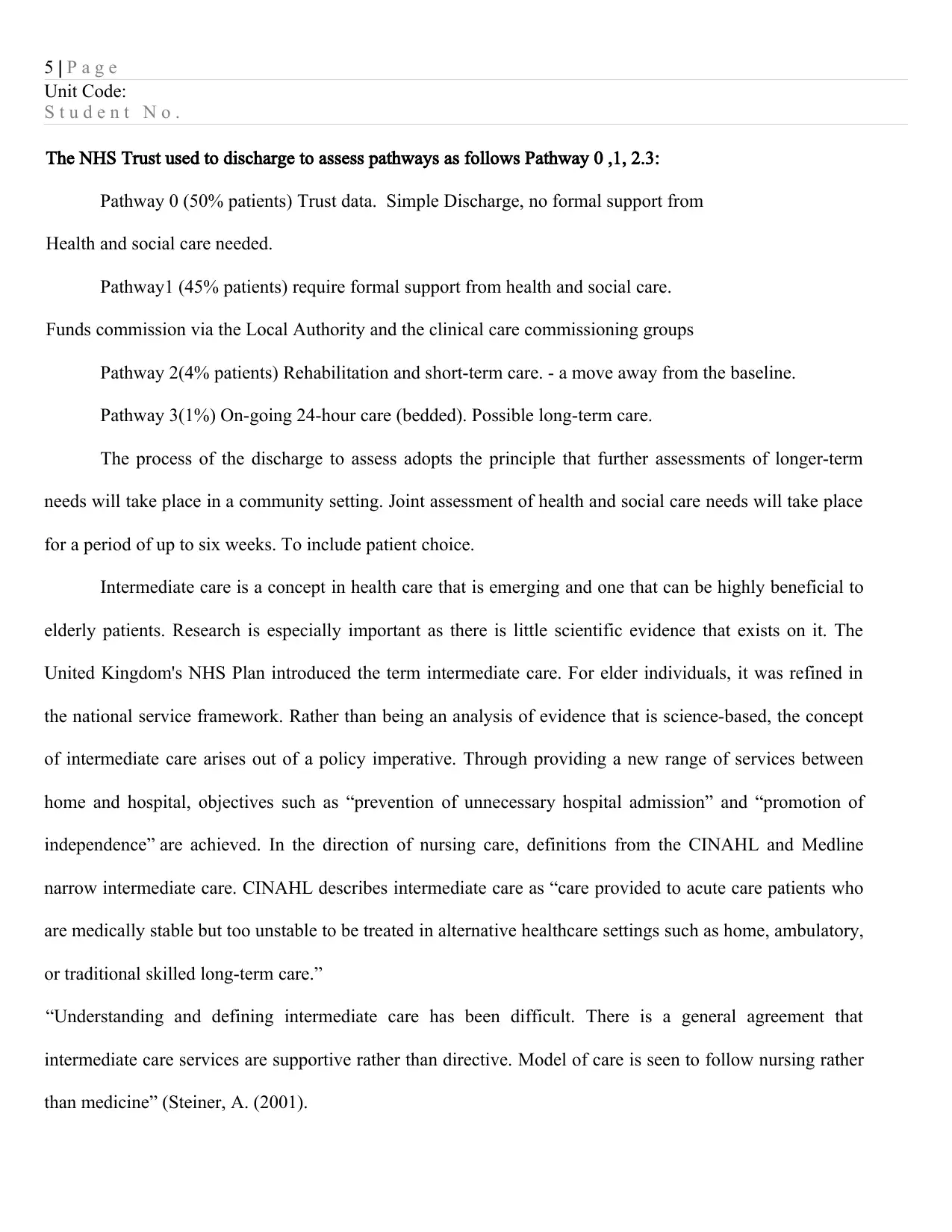
5 | P a g e
Unit Code:
S t u d e n t N o .
The NHS Trust used to discharge to assess pathways as follows Pathway 0 ,1, 2.3:
Pathway 0 (50% patients) Trust data. Simple Discharge, no formal support from
Health and social care needed.
Pathway1 (45% patients) require formal support from health and social care.
Funds commission via the Local Authority and the clinical care commissioning groups
Pathway 2(4% patients) Rehabilitation and short-term care. - a move away from the baseline.
Pathway 3(1%) On-going 24-hour care (bedded). Possible long-term care.
The process of the discharge to assess adopts the principle that further assessments of longer-term
needs will take place in a community setting. Joint assessment of health and social care needs will take place
for a period of up to six weeks. To include patient choice.
Intermediate care is a concept in health care that is emerging and one that can be highly beneficial to
elderly patients. Research is especially important as there is little scientific evidence that exists on it. The
United Kingdom's NHS Plan introduced the term intermediate care. For elder individuals, it was refined in
the national service framework. Rather than being an analysis of evidence that is science-based, the concept
of intermediate care arises out of a policy imperative. Through providing a new range of services between
home and hospital, objectives such as “prevention of unnecessary hospital admission” and “promotion of
independence” are achieved. In the direction of nursing care, definitions from the CINAHL and Medline
narrow intermediate care. CINAHL describes intermediate care as “care provided to acute care patients who
are medically stable but too unstable to be treated in alternative healthcare settings such as home, ambulatory,
or traditional skilled long-term care.”
“Understanding and defining intermediate care has been difficult. There is a general agreement that
intermediate care services are supportive rather than directive. Model of care is seen to follow nursing rather
than medicine” (Steiner, A. (2001).
Unit Code:
S t u d e n t N o .
The NHS Trust used to discharge to assess pathways as follows Pathway 0 ,1, 2.3:
Pathway 0 (50% patients) Trust data. Simple Discharge, no formal support from
Health and social care needed.
Pathway1 (45% patients) require formal support from health and social care.
Funds commission via the Local Authority and the clinical care commissioning groups
Pathway 2(4% patients) Rehabilitation and short-term care. - a move away from the baseline.
Pathway 3(1%) On-going 24-hour care (bedded). Possible long-term care.
The process of the discharge to assess adopts the principle that further assessments of longer-term
needs will take place in a community setting. Joint assessment of health and social care needs will take place
for a period of up to six weeks. To include patient choice.
Intermediate care is a concept in health care that is emerging and one that can be highly beneficial to
elderly patients. Research is especially important as there is little scientific evidence that exists on it. The
United Kingdom's NHS Plan introduced the term intermediate care. For elder individuals, it was refined in
the national service framework. Rather than being an analysis of evidence that is science-based, the concept
of intermediate care arises out of a policy imperative. Through providing a new range of services between
home and hospital, objectives such as “prevention of unnecessary hospital admission” and “promotion of
independence” are achieved. In the direction of nursing care, definitions from the CINAHL and Medline
narrow intermediate care. CINAHL describes intermediate care as “care provided to acute care patients who
are medically stable but too unstable to be treated in alternative healthcare settings such as home, ambulatory,
or traditional skilled long-term care.”
“Understanding and defining intermediate care has been difficult. There is a general agreement that
intermediate care services are supportive rather than directive. Model of care is seen to follow nursing rather
than medicine” (Steiner, A. (2001).
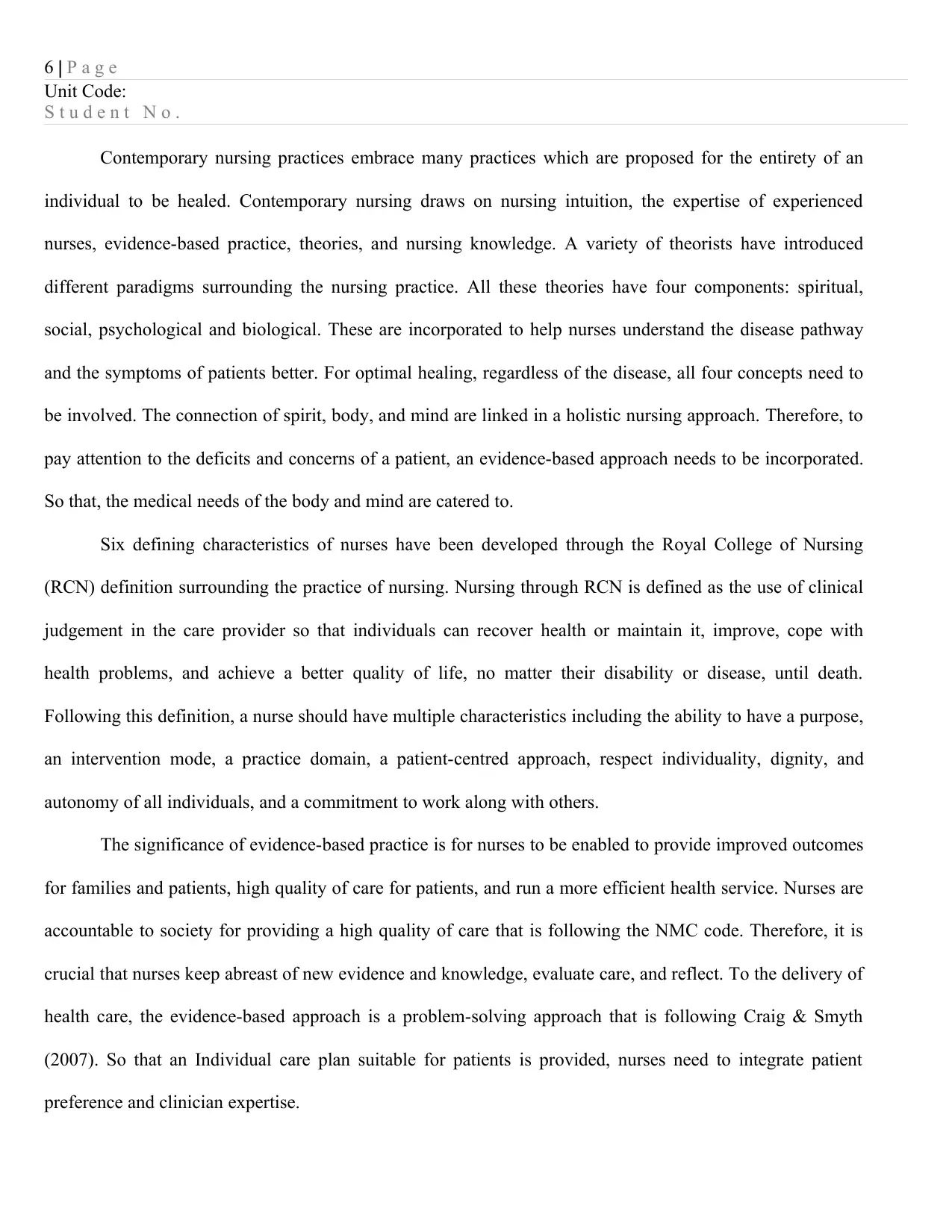
6 | P a g e
Unit Code:
S t u d e n t N o .
Contemporary nursing practices embrace many practices which are proposed for the entirety of an
individual to be healed. Contemporary nursing draws on nursing intuition, the expertise of experienced
nurses, evidence-based practice, theories, and nursing knowledge. A variety of theorists have introduced
different paradigms surrounding the nursing practice. All these theories have four components: spiritual,
social, psychological and biological. These are incorporated to help nurses understand the disease pathway
and the symptoms of patients better. For optimal healing, regardless of the disease, all four concepts need to
be involved. The connection of spirit, body, and mind are linked in a holistic nursing approach. Therefore, to
pay attention to the deficits and concerns of a patient, an evidence-based approach needs to be incorporated.
So that, the medical needs of the body and mind are catered to.
Six defining characteristics of nurses have been developed through the Royal College of Nursing
(RCN) definition surrounding the practice of nursing. Nursing through RCN is defined as the use of clinical
judgement in the care provider so that individuals can recover health or maintain it, improve, cope with
health problems, and achieve a better quality of life, no matter their disability or disease, until death.
Following this definition, a nurse should have multiple characteristics including the ability to have a purpose,
an intervention mode, a practice domain, a patient-centred approach, respect individuality, dignity, and
autonomy of all individuals, and a commitment to work along with others.
The significance of evidence-based practice is for nurses to be enabled to provide improved outcomes
for families and patients, high quality of care for patients, and run a more efficient health service. Nurses are
accountable to society for providing a high quality of care that is following the NMC code. Therefore, it is
crucial that nurses keep abreast of new evidence and knowledge, evaluate care, and reflect. To the delivery of
health care, the evidence-based approach is a problem-solving approach that is following Craig & Smyth
(2007). So that an Individual care plan suitable for patients is provided, nurses need to integrate patient
preference and clinician expertise.
Unit Code:
S t u d e n t N o .
Contemporary nursing practices embrace many practices which are proposed for the entirety of an
individual to be healed. Contemporary nursing draws on nursing intuition, the expertise of experienced
nurses, evidence-based practice, theories, and nursing knowledge. A variety of theorists have introduced
different paradigms surrounding the nursing practice. All these theories have four components: spiritual,
social, psychological and biological. These are incorporated to help nurses understand the disease pathway
and the symptoms of patients better. For optimal healing, regardless of the disease, all four concepts need to
be involved. The connection of spirit, body, and mind are linked in a holistic nursing approach. Therefore, to
pay attention to the deficits and concerns of a patient, an evidence-based approach needs to be incorporated.
So that, the medical needs of the body and mind are catered to.
Six defining characteristics of nurses have been developed through the Royal College of Nursing
(RCN) definition surrounding the practice of nursing. Nursing through RCN is defined as the use of clinical
judgement in the care provider so that individuals can recover health or maintain it, improve, cope with
health problems, and achieve a better quality of life, no matter their disability or disease, until death.
Following this definition, a nurse should have multiple characteristics including the ability to have a purpose,
an intervention mode, a practice domain, a patient-centred approach, respect individuality, dignity, and
autonomy of all individuals, and a commitment to work along with others.
The significance of evidence-based practice is for nurses to be enabled to provide improved outcomes
for families and patients, high quality of care for patients, and run a more efficient health service. Nurses are
accountable to society for providing a high quality of care that is following the NMC code. Therefore, it is
crucial that nurses keep abreast of new evidence and knowledge, evaluate care, and reflect. To the delivery of
health care, the evidence-based approach is a problem-solving approach that is following Craig & Smyth
(2007). So that an Individual care plan suitable for patients is provided, nurses need to integrate patient
preference and clinician expertise.
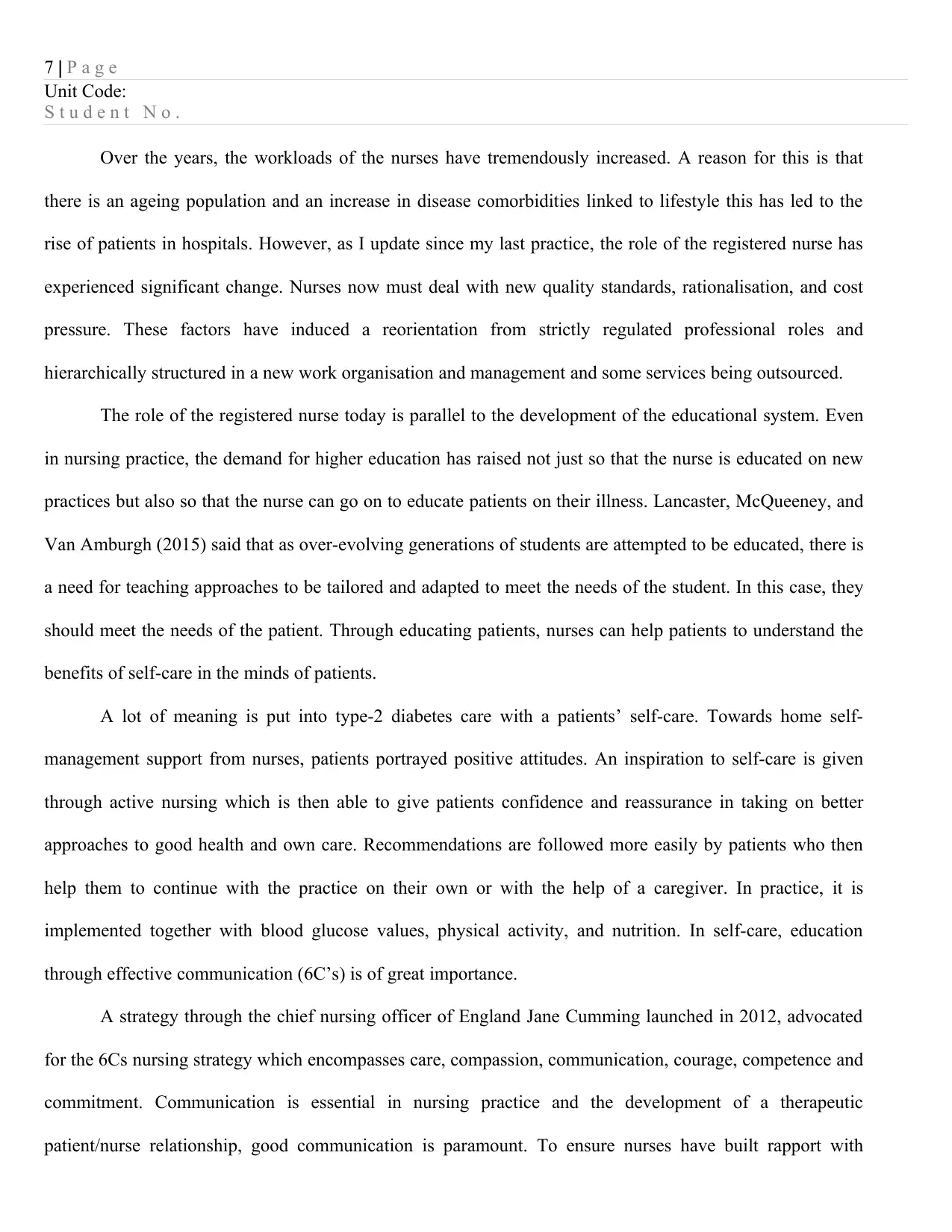
7 | P a g e
Unit Code:
S t u d e n t N o .
Over the years, the workloads of the nurses have tremendously increased. A reason for this is that
there is an ageing population and an increase in disease comorbidities linked to lifestyle this has led to the
rise of patients in hospitals. However, as I update since my last practice, the role of the registered nurse has
experienced significant change. Nurses now must deal with new quality standards, rationalisation, and cost
pressure. These factors have induced a reorientation from strictly regulated professional roles and
hierarchically structured in a new work organisation and management and some services being outsourced.
The role of the registered nurse today is parallel to the development of the educational system. Even
in nursing practice, the demand for higher education has raised not just so that the nurse is educated on new
practices but also so that the nurse can go on to educate patients on their illness. Lancaster, McQueeney, and
Van Amburgh (2015) said that as over-evolving generations of students are attempted to be educated, there is
a need for teaching approaches to be tailored and adapted to meet the needs of the student. In this case, they
should meet the needs of the patient. Through educating patients, nurses can help patients to understand the
benefits of self-care in the minds of patients.
A lot of meaning is put into type-2 diabetes care with a patients’ self-care. Towards home self-
management support from nurses, patients portrayed positive attitudes. An inspiration to self-care is given
through active nursing which is then able to give patients confidence and reassurance in taking on better
approaches to good health and own care. Recommendations are followed more easily by patients who then
help them to continue with the practice on their own or with the help of a caregiver. In practice, it is
implemented together with blood glucose values, physical activity, and nutrition. In self-care, education
through effective communication (6C’s) is of great importance.
A strategy through the chief nursing officer of England Jane Cumming launched in 2012, advocated
for the 6Cs nursing strategy which encompasses care, compassion, communication, courage, competence and
commitment. Communication is essential in nursing practice and the development of a therapeutic
patient/nurse relationship, good communication is paramount. To ensure nurses have built rapport with
Unit Code:
S t u d e n t N o .
Over the years, the workloads of the nurses have tremendously increased. A reason for this is that
there is an ageing population and an increase in disease comorbidities linked to lifestyle this has led to the
rise of patients in hospitals. However, as I update since my last practice, the role of the registered nurse has
experienced significant change. Nurses now must deal with new quality standards, rationalisation, and cost
pressure. These factors have induced a reorientation from strictly regulated professional roles and
hierarchically structured in a new work organisation and management and some services being outsourced.
The role of the registered nurse today is parallel to the development of the educational system. Even
in nursing practice, the demand for higher education has raised not just so that the nurse is educated on new
practices but also so that the nurse can go on to educate patients on their illness. Lancaster, McQueeney, and
Van Amburgh (2015) said that as over-evolving generations of students are attempted to be educated, there is
a need for teaching approaches to be tailored and adapted to meet the needs of the student. In this case, they
should meet the needs of the patient. Through educating patients, nurses can help patients to understand the
benefits of self-care in the minds of patients.
A lot of meaning is put into type-2 diabetes care with a patients’ self-care. Towards home self-
management support from nurses, patients portrayed positive attitudes. An inspiration to self-care is given
through active nursing which is then able to give patients confidence and reassurance in taking on better
approaches to good health and own care. Recommendations are followed more easily by patients who then
help them to continue with the practice on their own or with the help of a caregiver. In practice, it is
implemented together with blood glucose values, physical activity, and nutrition. In self-care, education
through effective communication (6C’s) is of great importance.
A strategy through the chief nursing officer of England Jane Cumming launched in 2012, advocated
for the 6Cs nursing strategy which encompasses care, compassion, communication, courage, competence and
commitment. Communication is essential in nursing practice and the development of a therapeutic
patient/nurse relationship, good communication is paramount. To ensure nurses have built rapport with
Paraphrase This Document
Need a fresh take? Get an instant paraphrase of this document with our AI Paraphraser
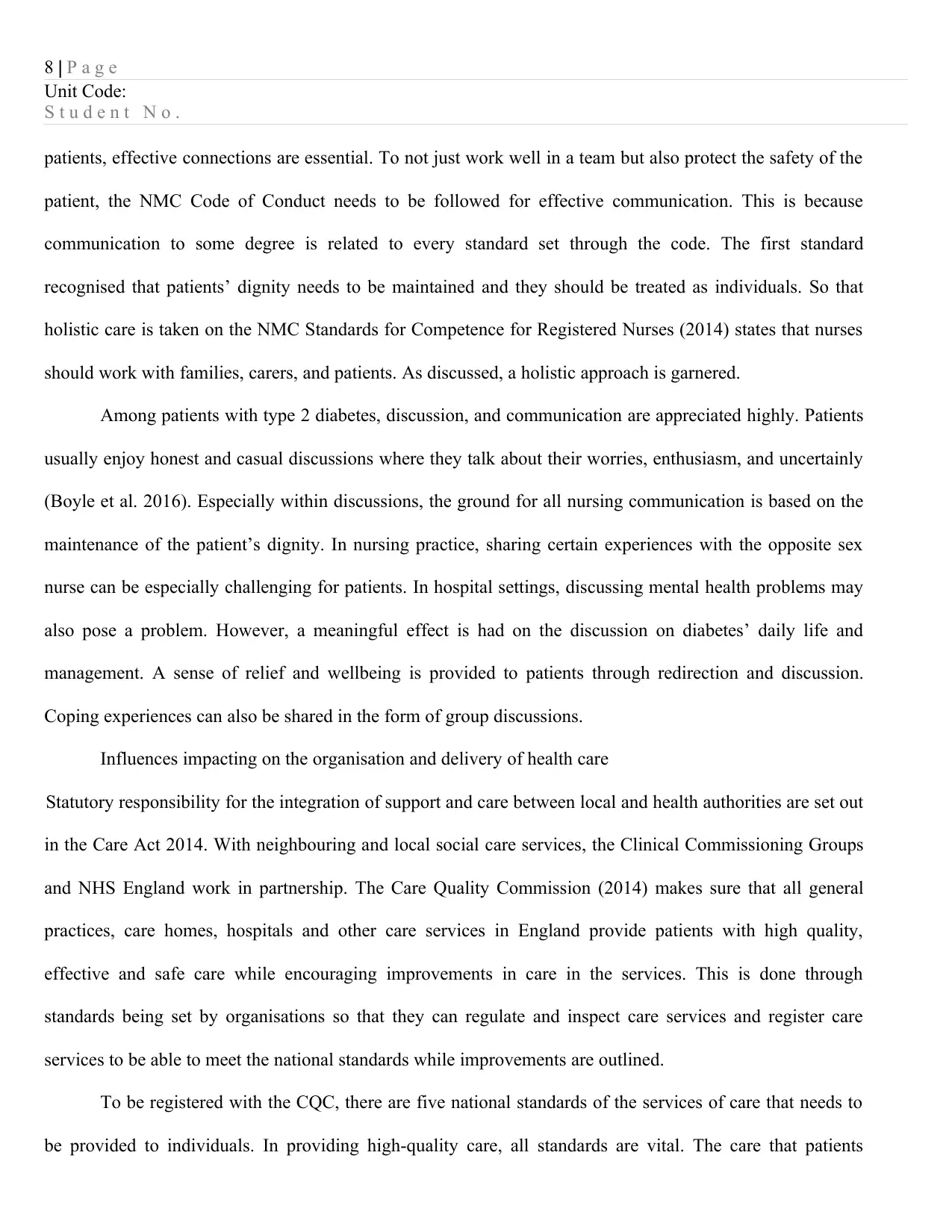
8 | P a g e
Unit Code:
S t u d e n t N o .
patients, effective connections are essential. To not just work well in a team but also protect the safety of the
patient, the NMC Code of Conduct needs to be followed for effective communication. This is because
communication to some degree is related to every standard set through the code. The first standard
recognised that patients’ dignity needs to be maintained and they should be treated as individuals. So that
holistic care is taken on the NMC Standards for Competence for Registered Nurses (2014) states that nurses
should work with families, carers, and patients. As discussed, a holistic approach is garnered.
Among patients with type 2 diabetes, discussion, and communication are appreciated highly. Patients
usually enjoy honest and casual discussions where they talk about their worries, enthusiasm, and uncertainly
(Boyle et al. 2016). Especially within discussions, the ground for all nursing communication is based on the
maintenance of the patient’s dignity. In nursing practice, sharing certain experiences with the opposite sex
nurse can be especially challenging for patients. In hospital settings, discussing mental health problems may
also pose a problem. However, a meaningful effect is had on the discussion on diabetes’ daily life and
management. A sense of relief and wellbeing is provided to patients through redirection and discussion.
Coping experiences can also be shared in the form of group discussions.
Influences impacting on the organisation and delivery of health care
Statutory responsibility for the integration of support and care between local and health authorities are set out
in the Care Act 2014. With neighbouring and local social care services, the Clinical Commissioning Groups
and NHS England work in partnership. The Care Quality Commission (2014) makes sure that all general
practices, care homes, hospitals and other care services in England provide patients with high quality,
effective and safe care while encouraging improvements in care in the services. This is done through
standards being set by organisations so that they can regulate and inspect care services and register care
services to be able to meet the national standards while improvements are outlined.
To be registered with the CQC, there are five national standards of the services of care that needs to
be provided to individuals. In providing high-quality care, all standards are vital. The care that patients
Unit Code:
S t u d e n t N o .
patients, effective connections are essential. To not just work well in a team but also protect the safety of the
patient, the NMC Code of Conduct needs to be followed for effective communication. This is because
communication to some degree is related to every standard set through the code. The first standard
recognised that patients’ dignity needs to be maintained and they should be treated as individuals. So that
holistic care is taken on the NMC Standards for Competence for Registered Nurses (2014) states that nurses
should work with families, carers, and patients. As discussed, a holistic approach is garnered.
Among patients with type 2 diabetes, discussion, and communication are appreciated highly. Patients
usually enjoy honest and casual discussions where they talk about their worries, enthusiasm, and uncertainly
(Boyle et al. 2016). Especially within discussions, the ground for all nursing communication is based on the
maintenance of the patient’s dignity. In nursing practice, sharing certain experiences with the opposite sex
nurse can be especially challenging for patients. In hospital settings, discussing mental health problems may
also pose a problem. However, a meaningful effect is had on the discussion on diabetes’ daily life and
management. A sense of relief and wellbeing is provided to patients through redirection and discussion.
Coping experiences can also be shared in the form of group discussions.
Influences impacting on the organisation and delivery of health care
Statutory responsibility for the integration of support and care between local and health authorities are set out
in the Care Act 2014. With neighbouring and local social care services, the Clinical Commissioning Groups
and NHS England work in partnership. The Care Quality Commission (2014) makes sure that all general
practices, care homes, hospitals and other care services in England provide patients with high quality,
effective and safe care while encouraging improvements in care in the services. This is done through
standards being set by organisations so that they can regulate and inspect care services and register care
services to be able to meet the national standards while improvements are outlined.
To be registered with the CQC, there are five national standards of the services of care that needs to
be provided to individuals. In providing high-quality care, all standards are vital. The care that patients
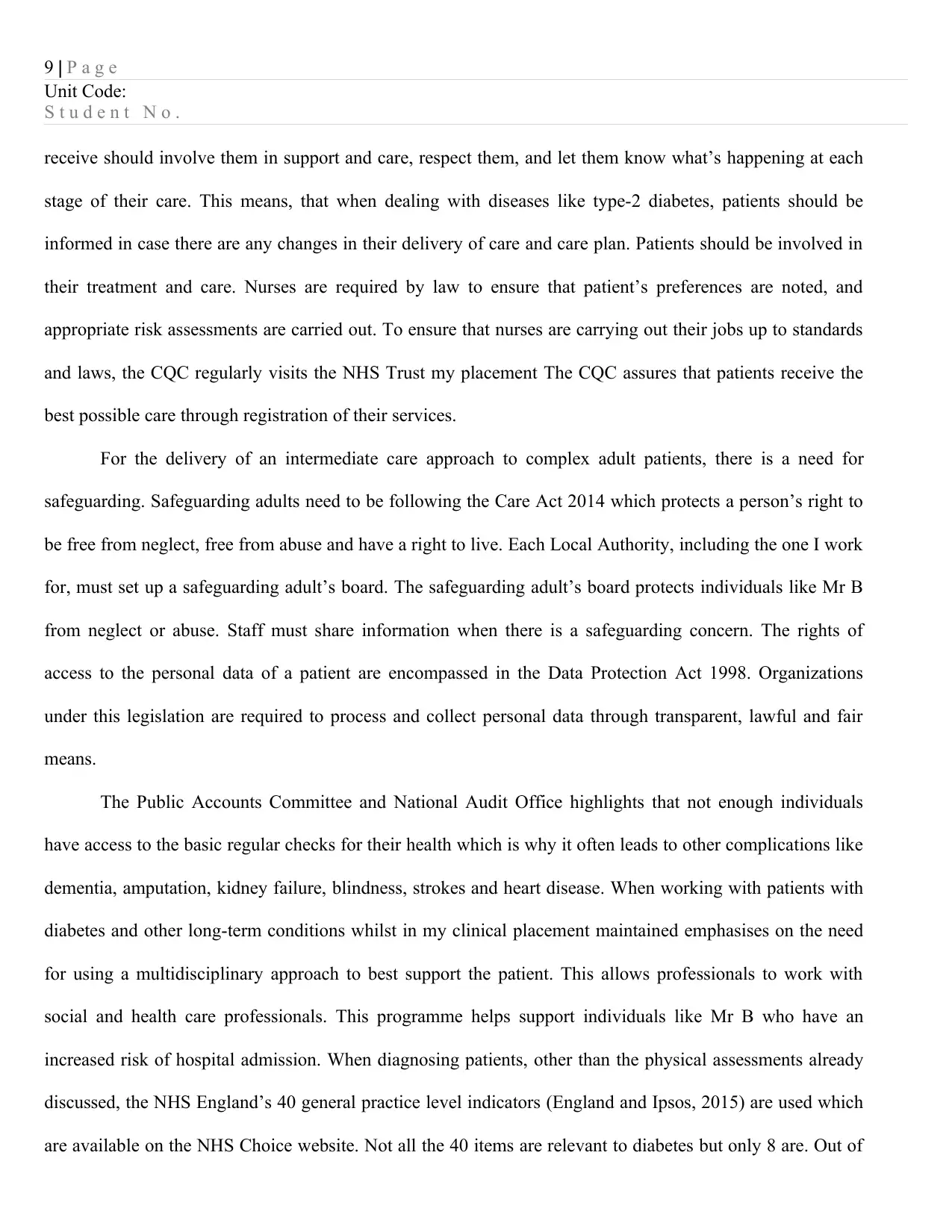
9 | P a g e
Unit Code:
S t u d e n t N o .
receive should involve them in support and care, respect them, and let them know what’s happening at each
stage of their care. This means, that when dealing with diseases like type-2 diabetes, patients should be
informed in case there are any changes in their delivery of care and care plan. Patients should be involved in
their treatment and care. Nurses are required by law to ensure that patient’s preferences are noted, and
appropriate risk assessments are carried out. To ensure that nurses are carrying out their jobs up to standards
and laws, the CQC regularly visits the NHS Trust my placement The CQC assures that patients receive the
best possible care through registration of their services.
For the delivery of an intermediate care approach to complex adult patients, there is a need for
safeguarding. Safeguarding adults need to be following the Care Act 2014 which protects a person’s right to
be free from neglect, free from abuse and have a right to live. Each Local Authority, including the one I work
for, must set up a safeguarding adult’s board. The safeguarding adult’s board protects individuals like Mr B
from neglect or abuse. Staff must share information when there is a safeguarding concern. The rights of
access to the personal data of a patient are encompassed in the Data Protection Act 1998. Organizations
under this legislation are required to process and collect personal data through transparent, lawful and fair
means.
The Public Accounts Committee and National Audit Office highlights that not enough individuals
have access to the basic regular checks for their health which is why it often leads to other complications like
dementia, amputation, kidney failure, blindness, strokes and heart disease. When working with patients with
diabetes and other long-term conditions whilst in my clinical placement maintained emphasises on the need
for using a multidisciplinary approach to best support the patient. This allows professionals to work with
social and health care professionals. This programme helps support individuals like Mr B who have an
increased risk of hospital admission. When diagnosing patients, other than the physical assessments already
discussed, the NHS England’s 40 general practice level indicators (England and Ipsos, 2015) are used which
are available on the NHS Choice website. Not all the 40 items are relevant to diabetes but only 8 are. Out of
Unit Code:
S t u d e n t N o .
receive should involve them in support and care, respect them, and let them know what’s happening at each
stage of their care. This means, that when dealing with diseases like type-2 diabetes, patients should be
informed in case there are any changes in their delivery of care and care plan. Patients should be involved in
their treatment and care. Nurses are required by law to ensure that patient’s preferences are noted, and
appropriate risk assessments are carried out. To ensure that nurses are carrying out their jobs up to standards
and laws, the CQC regularly visits the NHS Trust my placement The CQC assures that patients receive the
best possible care through registration of their services.
For the delivery of an intermediate care approach to complex adult patients, there is a need for
safeguarding. Safeguarding adults need to be following the Care Act 2014 which protects a person’s right to
be free from neglect, free from abuse and have a right to live. Each Local Authority, including the one I work
for, must set up a safeguarding adult’s board. The safeguarding adult’s board protects individuals like Mr B
from neglect or abuse. Staff must share information when there is a safeguarding concern. The rights of
access to the personal data of a patient are encompassed in the Data Protection Act 1998. Organizations
under this legislation are required to process and collect personal data through transparent, lawful and fair
means.
The Public Accounts Committee and National Audit Office highlights that not enough individuals
have access to the basic regular checks for their health which is why it often leads to other complications like
dementia, amputation, kidney failure, blindness, strokes and heart disease. When working with patients with
diabetes and other long-term conditions whilst in my clinical placement maintained emphasises on the need
for using a multidisciplinary approach to best support the patient. This allows professionals to work with
social and health care professionals. This programme helps support individuals like Mr B who have an
increased risk of hospital admission. When diagnosing patients, other than the physical assessments already
discussed, the NHS England’s 40 general practice level indicators (England and Ipsos, 2015) are used which
are available on the NHS Choice website. Not all the 40 items are relevant to diabetes but only 8 are. Out of
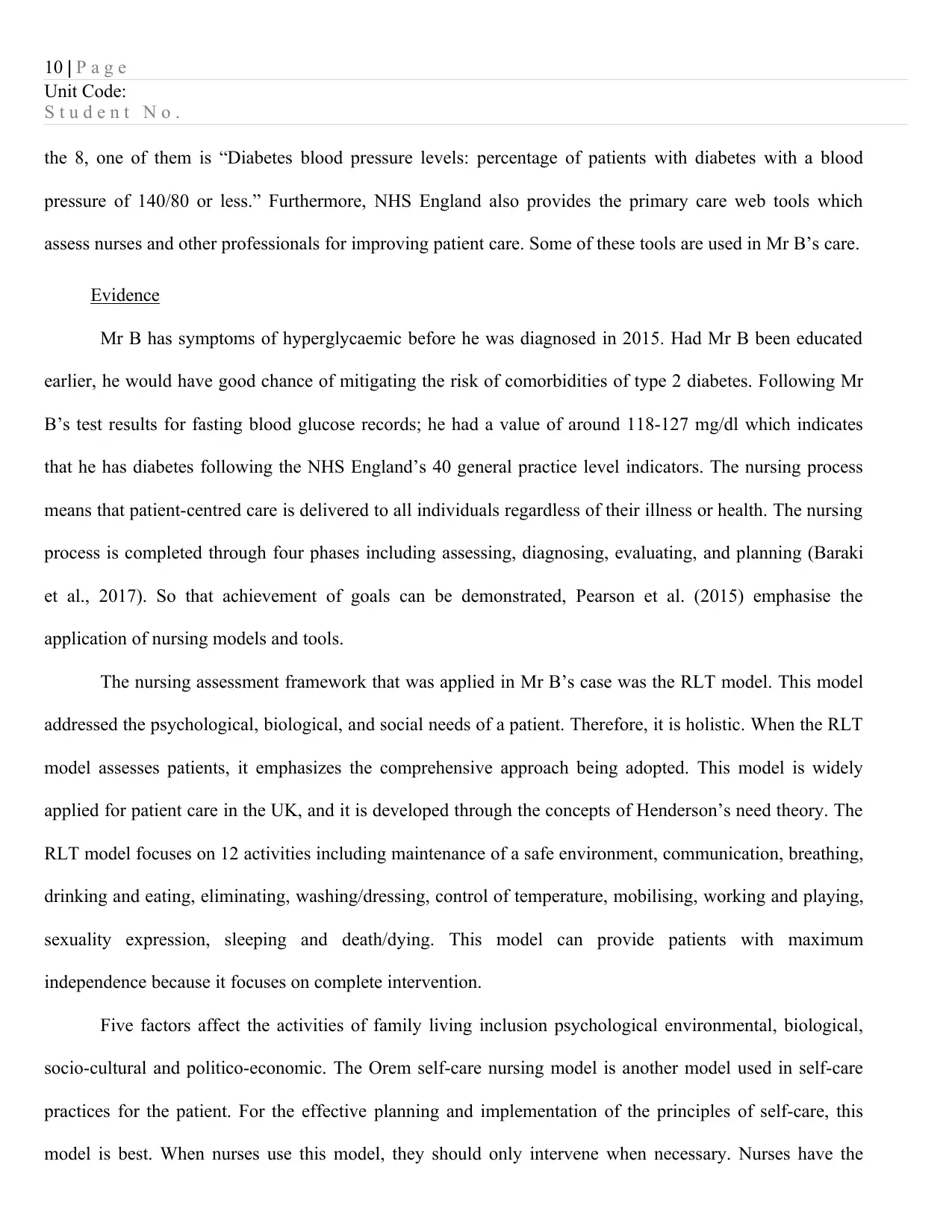
10 | P a g e
Unit Code:
S t u d e n t N o .
the 8, one of them is “Diabetes blood pressure levels: percentage of patients with diabetes with a blood
pressure of 140/80 or less.” Furthermore, NHS England also provides the primary care web tools which
assess nurses and other professionals for improving patient care. Some of these tools are used in Mr B’s care.
Evidence
Mr B has symptoms of hyperglycaemic before he was diagnosed in 2015. Had Mr B been educated
earlier, he would have good chance of mitigating the risk of comorbidities of type 2 diabetes. Following Mr
B’s test results for fasting blood glucose records; he had a value of around 118-127 mg/dl which indicates
that he has diabetes following the NHS England’s 40 general practice level indicators. The nursing process
means that patient-centred care is delivered to all individuals regardless of their illness or health. The nursing
process is completed through four phases including assessing, diagnosing, evaluating, and planning (Baraki
et al., 2017). So that achievement of goals can be demonstrated, Pearson et al. (2015) emphasise the
application of nursing models and tools.
The nursing assessment framework that was applied in Mr B’s case was the RLT model. This model
addressed the psychological, biological, and social needs of a patient. Therefore, it is holistic. When the RLT
model assesses patients, it emphasizes the comprehensive approach being adopted. This model is widely
applied for patient care in the UK, and it is developed through the concepts of Henderson’s need theory. The
RLT model focuses on 12 activities including maintenance of a safe environment, communication, breathing,
drinking and eating, eliminating, washing/dressing, control of temperature, mobilising, working and playing,
sexuality expression, sleeping and death/dying. This model can provide patients with maximum
independence because it focuses on complete intervention.
Five factors affect the activities of family living inclusion psychological environmental, biological,
socio-cultural and politico-economic. The Orem self-care nursing model is another model used in self-care
practices for the patient. For the effective planning and implementation of the principles of self-care, this
model is best. When nurses use this model, they should only intervene when necessary. Nurses have the
Unit Code:
S t u d e n t N o .
the 8, one of them is “Diabetes blood pressure levels: percentage of patients with diabetes with a blood
pressure of 140/80 or less.” Furthermore, NHS England also provides the primary care web tools which
assess nurses and other professionals for improving patient care. Some of these tools are used in Mr B’s care.
Evidence
Mr B has symptoms of hyperglycaemic before he was diagnosed in 2015. Had Mr B been educated
earlier, he would have good chance of mitigating the risk of comorbidities of type 2 diabetes. Following Mr
B’s test results for fasting blood glucose records; he had a value of around 118-127 mg/dl which indicates
that he has diabetes following the NHS England’s 40 general practice level indicators. The nursing process
means that patient-centred care is delivered to all individuals regardless of their illness or health. The nursing
process is completed through four phases including assessing, diagnosing, evaluating, and planning (Baraki
et al., 2017). So that achievement of goals can be demonstrated, Pearson et al. (2015) emphasise the
application of nursing models and tools.
The nursing assessment framework that was applied in Mr B’s case was the RLT model. This model
addressed the psychological, biological, and social needs of a patient. Therefore, it is holistic. When the RLT
model assesses patients, it emphasizes the comprehensive approach being adopted. This model is widely
applied for patient care in the UK, and it is developed through the concepts of Henderson’s need theory. The
RLT model focuses on 12 activities including maintenance of a safe environment, communication, breathing,
drinking and eating, eliminating, washing/dressing, control of temperature, mobilising, working and playing,
sexuality expression, sleeping and death/dying. This model can provide patients with maximum
independence because it focuses on complete intervention.
Five factors affect the activities of family living inclusion psychological environmental, biological,
socio-cultural and politico-economic. The Orem self-care nursing model is another model used in self-care
practices for the patient. For the effective planning and implementation of the principles of self-care, this
model is best. When nurses use this model, they should only intervene when necessary. Nurses have the
Secure Best Marks with AI Grader
Need help grading? Try our AI Grader for instant feedback on your assignments.
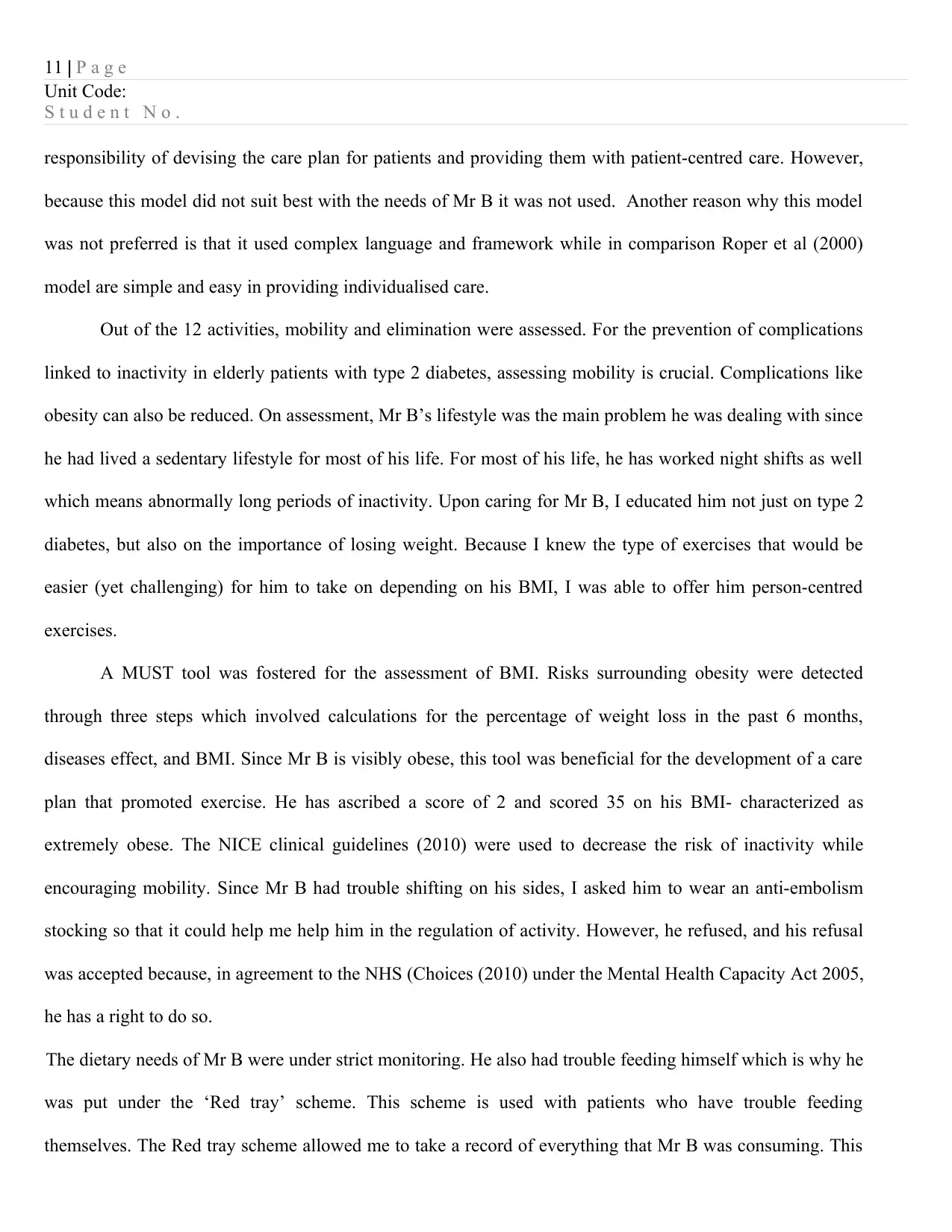
11 | P a g e
Unit Code:
S t u d e n t N o .
responsibility of devising the care plan for patients and providing them with patient-centred care. However,
because this model did not suit best with the needs of Mr B it was not used. Another reason why this model
was not preferred is that it used complex language and framework while in comparison Roper et al (2000)
model are simple and easy in providing individualised care.
Out of the 12 activities, mobility and elimination were assessed. For the prevention of complications
linked to inactivity in elderly patients with type 2 diabetes, assessing mobility is crucial. Complications like
obesity can also be reduced. On assessment, Mr B’s lifestyle was the main problem he was dealing with since
he had lived a sedentary lifestyle for most of his life. For most of his life, he has worked night shifts as well
which means abnormally long periods of inactivity. Upon caring for Mr B, I educated him not just on type 2
diabetes, but also on the importance of losing weight. Because I knew the type of exercises that would be
easier (yet challenging) for him to take on depending on his BMI, I was able to offer him person-centred
exercises.
A MUST tool was fostered for the assessment of BMI. Risks surrounding obesity were detected
through three steps which involved calculations for the percentage of weight loss in the past 6 months,
diseases effect, and BMI. Since Mr B is visibly obese, this tool was beneficial for the development of a care
plan that promoted exercise. He has ascribed a score of 2 and scored 35 on his BMI- characterized as
extremely obese. The NICE clinical guidelines (2010) were used to decrease the risk of inactivity while
encouraging mobility. Since Mr B had trouble shifting on his sides, I asked him to wear an anti-embolism
stocking so that it could help me help him in the regulation of activity. However, he refused, and his refusal
was accepted because, in agreement to the NHS (Choices (2010) under the Mental Health Capacity Act 2005,
he has a right to do so.
The dietary needs of Mr B were under strict monitoring. He also had trouble feeding himself which is why he
was put under the ‘Red tray’ scheme. This scheme is used with patients who have trouble feeding
themselves. The Red tray scheme allowed me to take a record of everything that Mr B was consuming. This
Unit Code:
S t u d e n t N o .
responsibility of devising the care plan for patients and providing them with patient-centred care. However,
because this model did not suit best with the needs of Mr B it was not used. Another reason why this model
was not preferred is that it used complex language and framework while in comparison Roper et al (2000)
model are simple and easy in providing individualised care.
Out of the 12 activities, mobility and elimination were assessed. For the prevention of complications
linked to inactivity in elderly patients with type 2 diabetes, assessing mobility is crucial. Complications like
obesity can also be reduced. On assessment, Mr B’s lifestyle was the main problem he was dealing with since
he had lived a sedentary lifestyle for most of his life. For most of his life, he has worked night shifts as well
which means abnormally long periods of inactivity. Upon caring for Mr B, I educated him not just on type 2
diabetes, but also on the importance of losing weight. Because I knew the type of exercises that would be
easier (yet challenging) for him to take on depending on his BMI, I was able to offer him person-centred
exercises.
A MUST tool was fostered for the assessment of BMI. Risks surrounding obesity were detected
through three steps which involved calculations for the percentage of weight loss in the past 6 months,
diseases effect, and BMI. Since Mr B is visibly obese, this tool was beneficial for the development of a care
plan that promoted exercise. He has ascribed a score of 2 and scored 35 on his BMI- characterized as
extremely obese. The NICE clinical guidelines (2010) were used to decrease the risk of inactivity while
encouraging mobility. Since Mr B had trouble shifting on his sides, I asked him to wear an anti-embolism
stocking so that it could help me help him in the regulation of activity. However, he refused, and his refusal
was accepted because, in agreement to the NHS (Choices (2010) under the Mental Health Capacity Act 2005,
he has a right to do so.
The dietary needs of Mr B were under strict monitoring. He also had trouble feeding himself which is why he
was put under the ‘Red tray’ scheme. This scheme is used with patients who have trouble feeding
themselves. The Red tray scheme allowed me to take a record of everything that Mr B was consuming. This
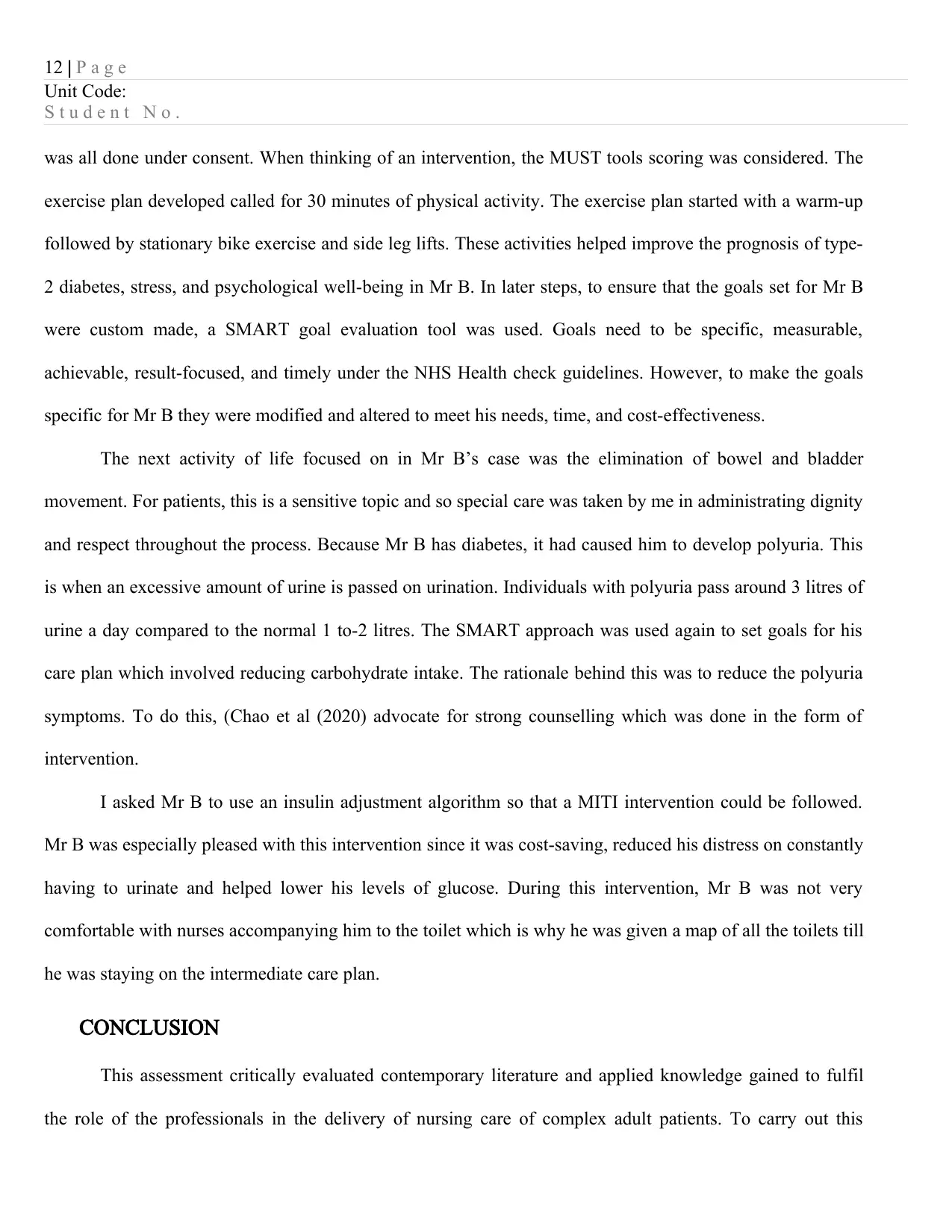
12 | P a g e
Unit Code:
S t u d e n t N o .
was all done under consent. When thinking of an intervention, the MUST tools scoring was considered. The
exercise plan developed called for 30 minutes of physical activity. The exercise plan started with a warm-up
followed by stationary bike exercise and side leg lifts. These activities helped improve the prognosis of type-
2 diabetes, stress, and psychological well-being in Mr B. In later steps, to ensure that the goals set for Mr B
were custom made, a SMART goal evaluation tool was used. Goals need to be specific, measurable,
achievable, result-focused, and timely under the NHS Health check guidelines. However, to make the goals
specific for Mr B they were modified and altered to meet his needs, time, and cost-effectiveness.
The next activity of life focused on in Mr B’s case was the elimination of bowel and bladder
movement. For patients, this is a sensitive topic and so special care was taken by me in administrating dignity
and respect throughout the process. Because Mr B has diabetes, it had caused him to develop polyuria. This
is when an excessive amount of urine is passed on urination. Individuals with polyuria pass around 3 litres of
urine a day compared to the normal 1 to-2 litres. The SMART approach was used again to set goals for his
care plan which involved reducing carbohydrate intake. The rationale behind this was to reduce the polyuria
symptoms. To do this, (Chao et al (2020) advocate for strong counselling which was done in the form of
intervention.
I asked Mr B to use an insulin adjustment algorithm so that a MITI intervention could be followed.
Mr B was especially pleased with this intervention since it was cost-saving, reduced his distress on constantly
having to urinate and helped lower his levels of glucose. During this intervention, Mr B was not very
comfortable with nurses accompanying him to the toilet which is why he was given a map of all the toilets till
he was staying on the intermediate care plan.
CONCLUSION
This assessment critically evaluated contemporary literature and applied knowledge gained to fulfil
the role of the professionals in the delivery of nursing care of complex adult patients. To carry out this
Unit Code:
S t u d e n t N o .
was all done under consent. When thinking of an intervention, the MUST tools scoring was considered. The
exercise plan developed called for 30 minutes of physical activity. The exercise plan started with a warm-up
followed by stationary bike exercise and side leg lifts. These activities helped improve the prognosis of type-
2 diabetes, stress, and psychological well-being in Mr B. In later steps, to ensure that the goals set for Mr B
were custom made, a SMART goal evaluation tool was used. Goals need to be specific, measurable,
achievable, result-focused, and timely under the NHS Health check guidelines. However, to make the goals
specific for Mr B they were modified and altered to meet his needs, time, and cost-effectiveness.
The next activity of life focused on in Mr B’s case was the elimination of bowel and bladder
movement. For patients, this is a sensitive topic and so special care was taken by me in administrating dignity
and respect throughout the process. Because Mr B has diabetes, it had caused him to develop polyuria. This
is when an excessive amount of urine is passed on urination. Individuals with polyuria pass around 3 litres of
urine a day compared to the normal 1 to-2 litres. The SMART approach was used again to set goals for his
care plan which involved reducing carbohydrate intake. The rationale behind this was to reduce the polyuria
symptoms. To do this, (Chao et al (2020) advocate for strong counselling which was done in the form of
intervention.
I asked Mr B to use an insulin adjustment algorithm so that a MITI intervention could be followed.
Mr B was especially pleased with this intervention since it was cost-saving, reduced his distress on constantly
having to urinate and helped lower his levels of glucose. During this intervention, Mr B was not very
comfortable with nurses accompanying him to the toilet which is why he was given a map of all the toilets till
he was staying on the intermediate care plan.
CONCLUSION
This assessment critically evaluated contemporary literature and applied knowledge gained to fulfil
the role of the professionals in the delivery of nursing care of complex adult patients. To carry out this

13 | P a g e
Unit Code:
S t u d e n t N o .
assessment, the influences impacted on the delivery of health care and the organisation was considered. This
included social and health policies and key legislations.
Unit Code:
S t u d e n t N o .
assessment, the influences impacted on the delivery of health care and the organisation was considered. This
included social and health policies and key legislations.
Paraphrase This Document
Need a fresh take? Get an instant paraphrase of this document with our AI Paraphraser
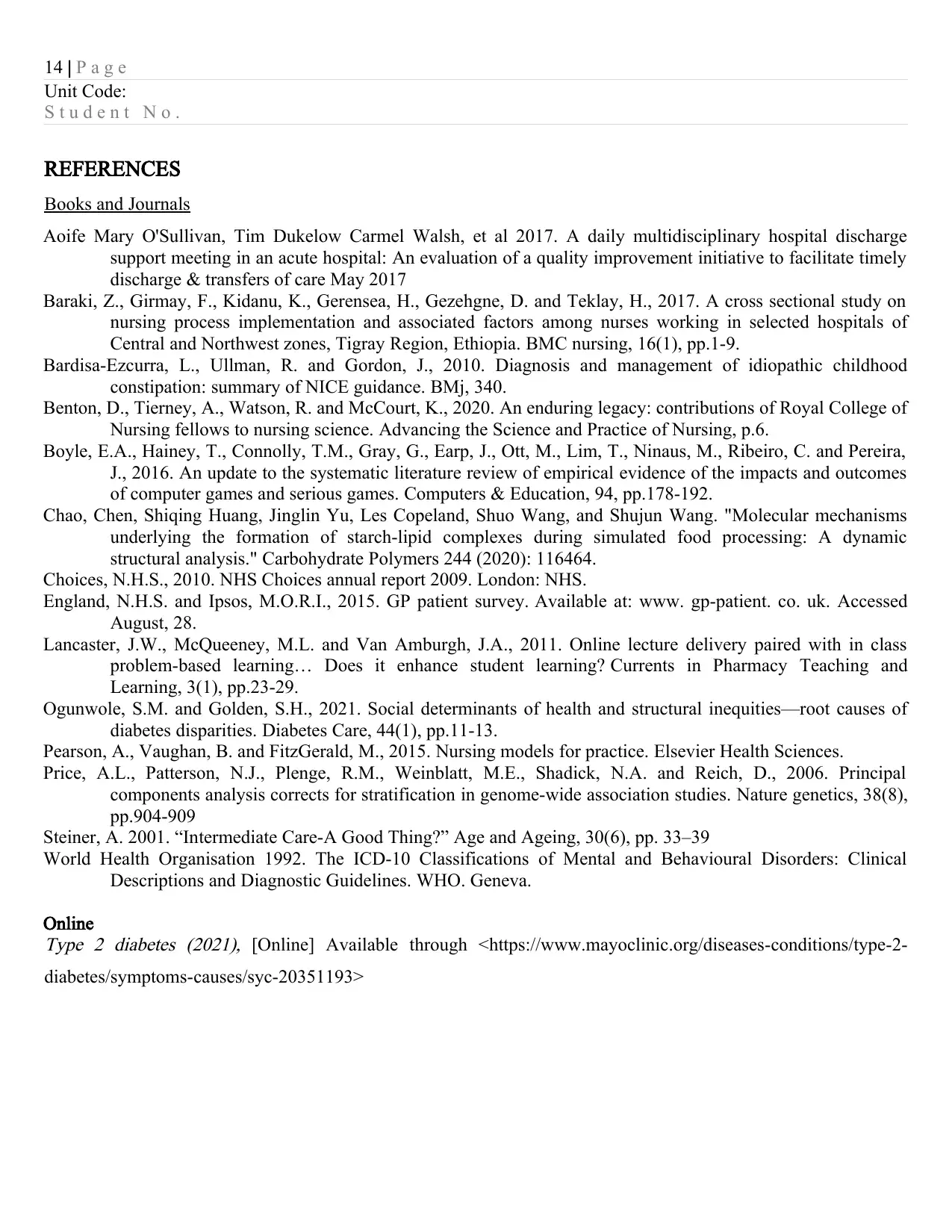
14 | P a g e
Unit Code:
S t u d e n t N o .
REFERENCES
Books and Journals
Aoife Mary O'Sullivan, Tim Dukelow Carmel Walsh, et al 2017. A daily multidisciplinary hospital discharge
support meeting in an acute hospital: An evaluation of a quality improvement initiative to facilitate timely
discharge & transfers of care May 2017
Baraki, Z., Girmay, F., Kidanu, K., Gerensea, H., Gezehgne, D. and Teklay, H., 2017. A cross sectional study on
nursing process implementation and associated factors among nurses working in selected hospitals of
Central and Northwest zones, Tigray Region, Ethiopia. BMC nursing, 16(1), pp.1-9.
Bardisa-Ezcurra, L., Ullman, R. and Gordon, J., 2010. Diagnosis and management of idiopathic childhood
constipation: summary of NICE guidance. BMj, 340.
Benton, D., Tierney, A., Watson, R. and McCourt, K., 2020. An enduring legacy: contributions of Royal College of
Nursing fellows to nursing science. Advancing the Science and Practice of Nursing, p.6.
Boyle, E.A., Hainey, T., Connolly, T.M., Gray, G., Earp, J., Ott, M., Lim, T., Ninaus, M., Ribeiro, C. and Pereira,
J., 2016. An update to the systematic literature review of empirical evidence of the impacts and outcomes
of computer games and serious games. Computers & Education, 94, pp.178-192.
Chao, Chen, Shiqing Huang, Jinglin Yu, Les Copeland, Shuo Wang, and Shujun Wang. "Molecular mechanisms
underlying the formation of starch-lipid complexes during simulated food processing: A dynamic
structural analysis." Carbohydrate Polymers 244 (2020): 116464.
Choices, N.H.S., 2010. NHS Choices annual report 2009. London: NHS.
England, N.H.S. and Ipsos, M.O.R.I., 2015. GP patient survey. Available at: www. gp-patient. co. uk. Accessed
August, 28.
Lancaster, J.W., McQueeney, M.L. and Van Amburgh, J.A., 2011. Online lecture delivery paired with in class
problem-based learning… Does it enhance student learning? Currents in Pharmacy Teaching and
Learning, 3(1), pp.23-29.
Ogunwole, S.M. and Golden, S.H., 2021. Social determinants of health and structural inequities—root causes of
diabetes disparities. Diabetes Care, 44(1), pp.11-13.
Pearson, A., Vaughan, B. and FitzGerald, M., 2015. Nursing models for practice. Elsevier Health Sciences.
Price, A.L., Patterson, N.J., Plenge, R.M., Weinblatt, M.E., Shadick, N.A. and Reich, D., 2006. Principal
components analysis corrects for stratification in genome-wide association studies. Nature genetics, 38(8),
pp.904-909
Steiner, A. 2001. “Intermediate Care-A Good Thing?” Age and Ageing, 30(6), pp. 33–39
World Health Organisation 1992. The ICD-10 Classifications of Mental and Behavioural Disorders: Clinical
Descriptions and Diagnostic Guidelines. WHO. Geneva.
Online
Type 2 diabetes (2021), [Online] Available through <https://www.mayoclinic.org/diseases-conditions/type-2-
diabetes/symptoms-causes/syc-20351193>
Unit Code:
S t u d e n t N o .
REFERENCES
Books and Journals
Aoife Mary O'Sullivan, Tim Dukelow Carmel Walsh, et al 2017. A daily multidisciplinary hospital discharge
support meeting in an acute hospital: An evaluation of a quality improvement initiative to facilitate timely
discharge & transfers of care May 2017
Baraki, Z., Girmay, F., Kidanu, K., Gerensea, H., Gezehgne, D. and Teklay, H., 2017. A cross sectional study on
nursing process implementation and associated factors among nurses working in selected hospitals of
Central and Northwest zones, Tigray Region, Ethiopia. BMC nursing, 16(1), pp.1-9.
Bardisa-Ezcurra, L., Ullman, R. and Gordon, J., 2010. Diagnosis and management of idiopathic childhood
constipation: summary of NICE guidance. BMj, 340.
Benton, D., Tierney, A., Watson, R. and McCourt, K., 2020. An enduring legacy: contributions of Royal College of
Nursing fellows to nursing science. Advancing the Science and Practice of Nursing, p.6.
Boyle, E.A., Hainey, T., Connolly, T.M., Gray, G., Earp, J., Ott, M., Lim, T., Ninaus, M., Ribeiro, C. and Pereira,
J., 2016. An update to the systematic literature review of empirical evidence of the impacts and outcomes
of computer games and serious games. Computers & Education, 94, pp.178-192.
Chao, Chen, Shiqing Huang, Jinglin Yu, Les Copeland, Shuo Wang, and Shujun Wang. "Molecular mechanisms
underlying the formation of starch-lipid complexes during simulated food processing: A dynamic
structural analysis." Carbohydrate Polymers 244 (2020): 116464.
Choices, N.H.S., 2010. NHS Choices annual report 2009. London: NHS.
England, N.H.S. and Ipsos, M.O.R.I., 2015. GP patient survey. Available at: www. gp-patient. co. uk. Accessed
August, 28.
Lancaster, J.W., McQueeney, M.L. and Van Amburgh, J.A., 2011. Online lecture delivery paired with in class
problem-based learning… Does it enhance student learning? Currents in Pharmacy Teaching and
Learning, 3(1), pp.23-29.
Ogunwole, S.M. and Golden, S.H., 2021. Social determinants of health and structural inequities—root causes of
diabetes disparities. Diabetes Care, 44(1), pp.11-13.
Pearson, A., Vaughan, B. and FitzGerald, M., 2015. Nursing models for practice. Elsevier Health Sciences.
Price, A.L., Patterson, N.J., Plenge, R.M., Weinblatt, M.E., Shadick, N.A. and Reich, D., 2006. Principal
components analysis corrects for stratification in genome-wide association studies. Nature genetics, 38(8),
pp.904-909
Steiner, A. 2001. “Intermediate Care-A Good Thing?” Age and Ageing, 30(6), pp. 33–39
World Health Organisation 1992. The ICD-10 Classifications of Mental and Behavioural Disorders: Clinical
Descriptions and Diagnostic Guidelines. WHO. Geneva.
Online
Type 2 diabetes (2021), [Online] Available through <https://www.mayoclinic.org/diseases-conditions/type-2-
diabetes/symptoms-causes/syc-20351193>
1 out of 14
Related Documents
Your All-in-One AI-Powered Toolkit for Academic Success.
+13062052269
info@desklib.com
Available 24*7 on WhatsApp / Email
![[object Object]](/_next/static/media/star-bottom.7253800d.svg)
Unlock your academic potential
© 2024 | Zucol Services PVT LTD | All rights reserved.





